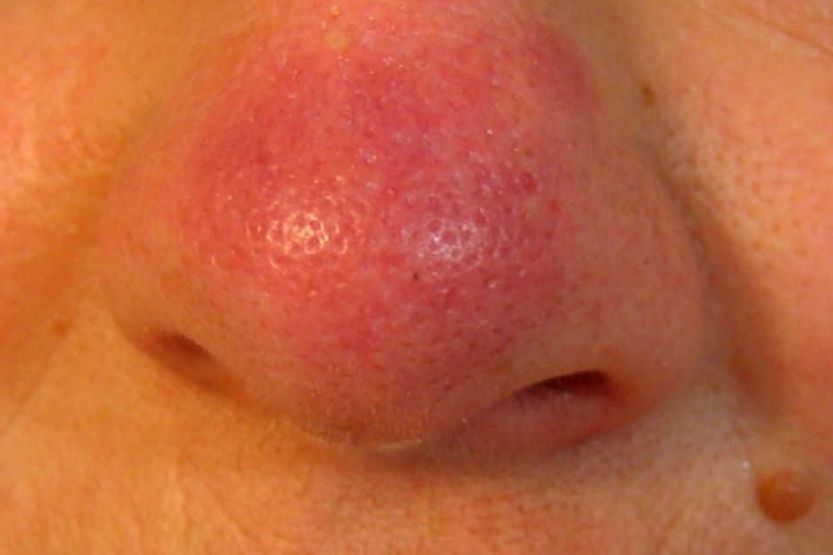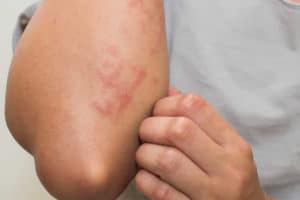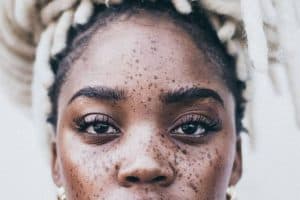If you have a bleeding pore on your nose, it’s always best to consult your doctor. It could be a minor skin condition only, but it could also be a serious one. In this article, we will talk about the probable causes of a bleeding pore on the nose.
There are several probable causes why nose pores bleed. Among these are the following:
- Acne
- Dry Skin
- Basal Cell Skin Cancer
- Melanoma
- Spider Nevi
- Measles
- Chicken Pox
- Rash
- Rosacea
- Lupus
- Lupus Pernio
Read on to learn more about the possible causes and treatments for nose pores that bleed.
Bleeding Pore on Nose

Often, lesions on the nose, or the face as a whole, are harmless. This is because they are often noticed immediately early in development due to their location. So, they usually get treatment before they get worse.
If you notice a pore on your nose that won’t stop bleeding, make sure to apply some first aid treatment. If it still doesn’t heal within two weeks, don’t think twice about scheduling an appointment with your doctor.
Now, let’s briefly discuss each one of the above-mentioned probable causes of bleeding nose pores.
1. Acne
Acne is one of the probable causes of nose pore bleeding. It is a skin condition occurring when hair follicles are clogged with dead skin cells and oil. While it is most common among teenagers, it nonetheless affects people of all ages. This particularly occurs among adults with susceptible skin.
Our nose has thicker skin on its sides and its tip. It has more pores too, which secrete oil or sebum. At the same time, we have thinner skin on the nose bridge and its sidewalls. These areas are also not as populated with sebaceous glands.
In most cases, a pimple or acne develops on the oiliest areas of the nose. You most likely have a pimple or acne on the nose if you have these symptoms:
- Tiny red spot on the nose
- The spot is like a very tiny red lump
- It may have a tiny hole in the middle of it
There are many over-the-counter products in drugstores that can treat acne. You may start by applying a mild facial cleansing product to your face. Make sure, though, that it doesn’t contain any harsh ingredients.
If the red spot doesn’t disappear after two weeks, consider visiting your doctor or dermatologist.
2. Dry Skin
It is also possible that the tiny red spot on your nose that causes bleeding is due to dry skin. There are many reasons why dryness of the skin occurs. Among these are sunburn, dehydration, or skin reaction to weather conditions.
In some cases, you will experience dead skin falling out. This typically occurs when the skin underneath the flaky skin has not yet fully developed.
There are moisturizing facial creams that you can use to treat this skin condition. But in case the over-the-counter skincare products are not effective on your skin, don’t hesitate to consult your doctor or dermatologist. This way, they can prescribe a more potent medication for you.
If you experience dry skin to the point that your nose pores are bleeding, the best move is always to consult your doctor. Dry skin may not be a serious skin condition, but it might lead to serious ones. It can be a symptom of such skin issues as eczema or psoriasis or such illnesses as kidney failure, malnutrition, hypothyroidism, and diabetes.
3. Basal Cell Skin Cancer
The Basal Cell Skin Cancer or Basal Cell Carcinoma is more common in people with:
- Frequent exposure to the sun
- Moles
- Light-colored eyes
- Fair complexion
Typically, basal cell skin cancer is painless and appears as a tiny red patch of skin on the nose. The common symptoms are the following:
- Bleeding sore
- Flaky or dry skin
- Highly noticeable blood vessels around the area
If you notice these symptoms and a pore on your nose won’t stop bleeding after two weeks, it’s best to consult a doctor. If you are diagnosed with basal cell skin cancer, your doctor will discuss the different treatment options. These options may include chemotherapy, cryosurgery, or excision, among others.
Basal cell carcinoma is, in most cases, treatable. But if it is left untreated, it can spread across the skin tissue and lead to disfigurement. Even if it is not a serious condition, it is possible to spread and metastasize to other body parts that might, unfortunately, lead to a serious illness.
4. Melanoma
Melanoma is also a type of skin cancer. It starts in the pigment-producing cells of the human body. At times, melanoma manifests as a red spot on the nose that sometimes bleeds. Other symptoms include the following:
- Scaly red spot on the nose
- Flaky, red spot on the nose
- Appears with brown or tan spots at times
- Sometimes disappears and reappears after a few days.
If you notice that you are experiencing these symptoms, you are highly advised to consult a doctor. Don’t wait until the red spot grows bigger or gets worse.
5. Spider Nevi

Spider nevi are prominent blood vessels that appear on the face, neck, and chest areas. Typically, 10% of the population encounters this skin condition. Spider nevi appear like red lumps with blood vessels radiating in a spiderweb-like pattern from the center of the lump.
In most cases, spider nevi occur in people with a liver issue or suffering from carcinoid syndrome. Patients initially experience having a slightly raised red spot on the nose. Then, they notice that the spot has a “head” in the middle, and the blood vessels appear to resemble spider legs.
Spider nevi are commonly treated by laser treatment using pulse dye laser. After one or two laser treatments, the red spots disappear without damaging the skin. However, small bruises in the treated areas may be visible until after a few days after treatment.
6. Measles
If you have measles, you will experience many red spots all over your face and body. This is usually accompanied by flu-like symptoms such as a fever, cough, or runny nose.
But before you can confirm that it is indeed measles, you will initially notice a red spot or two on your face. In some cases, the red spot appears on the nose. At times, it is even bleeding. Then, you will notice more and more red spots appearing not only on the face but also on different parts of your body.
Measles results from a virus that forms part of the paramyxovirus family. It is commonly passed through direct contact and the air. The respiratory tract is initially infected by the virus and gradually spreads throughout the body.
This illness normally lasts for 5 to 7 days. But the measle rash typically disappears after 2 to 3 weeks. So, it is advisable to use mild soap when bathing while you still have the measle rash. As for your face, apply mild facial soap. That way, you will not irritate your face and will not cause bleeding of pores.
7. Chickenpox
If you notice a red spot on your nose that seemingly resembles a pimple or an insect bite, consider the fact that it could be chickenpox.
Chickenpox usually manifests with a mere red spot on the face or another part of the body. That one red spot is noticeable, but you will most likely ignore it since you would initially think it is a pimple or an insect bite.
Within 2 to 4 days, you will notice that more and more red spots appear on your face and other parts of the body. The appearance gets worse too. So, don’t panic if they suddenly look like blisters filled with fluid.
Like measles, chickenpox is accompanied by fever. Typically, you don’t need to get admitted to a hospital for treatment. You can heal at home by taking pain relievers and other natural remedies. But it is always best to get a medical prescription from your doctor.
Full recovery from chickenpox commonly occurs 7 to 10 days after symptoms initially manifest.
8. Rash
Rashes that occur on the nose, around the nose, and around the mouth are collectively called perioral dermatitis. At times, this rash even causes the nose pore to bleed. If you use a topical steroid facial cream, the rash is probably the cream’s side effect.
However, steroid creams are only one of the many probable causes. It can be other types of medication that your body is reacting to. Rashes can also result from the food you eat. Suffice it to say that you have to figure out what triggers your rashes.
Your doctor may ask you to take a topical anti-acne cream or oral antibiotics. You may also use a moisturizing facial cream or lotion to help treat the redness and dryness. Just make sure that whatever you apply on your face doesn’t have harsh ingredients.
9. Rosacea
Rosacea is another type of skin condition wherein blood vessels become extremely noticeable on the face, causing redness of the face’s nose. This may also appear like tiny, red, pus-filled bumps, causing the nose pore or the facial pores to bleed.
This skin condition causes your face to encounter a sting, burn, or itch. So, be careful with the skincare products that you use to prevent experiencing rosacea.
Overexposure to sunlight and hairspray are two common rosacea triggers. Other triggers include alcohol drinking, stress, heat, and spicy foods, among others.
10. Lupus
Lupus is an illness wherein the immune system of patients attacks their own organs and tissues. Many lupus patients experience purplish or red rash extending from the bridge of the nose over to the cheeks. The pattern somewhat resembles the shape of a butterfly.
The lupus rash, also known as the malar rash, varies in texture. Sometimes, it is smooth. Other times, it is scaly or bumpy. This can be treated using a topical anti-inflammatory immunosuppressant cream such as tacrolimus or pimecrolimus.
This skin condition doesn’t only occur on the nose and cheeks. Also, check your fingernails for changes. If you have lupus, you will most likely experience having nails that crack or even fall off. Then, its base has rashes and, if the condition is worse, your nails will look red and puffy.
Lupus patients have high sensitivity to the sun or any other form of ultraviolet (UV) light. Sun or UV light exposure will most likely trigger a skin rash. Unfortunately, this may also worsen other symptoms of lupus.
Lupus Pernio

Lupus pernio refers to a chronic raised and hardened skin lesion appearing on the nose, ears, cheeks, lips, and forehead. Unfortunately, the cause of this type of skin condition is not yet known.
There are different ways to treat lupus pernio. These include the following:
- Systemic therapies such as biological agents, methotrexate, hydroxychloroquine, and systemic corticosteroids
- Laser treatments such as pulsed dye and carbon dioxide lasers
- Intralesional steroid injections
- Topical corticosteroids
There is a tendency for lupus pernio to persist for years wherein patients must strictly be under observation, particularly in their lung and cardiac function.
Conclusion – Bleeding Pores on the Nose
There are several probable causes why nose pores bleed. Among these are the following:
- Acne
- Dry Skin
- Basal Cell Skin Cancer
- Melanoma
- Spider Nevi
- Measles
- Chicken Pox
- Rash
- Rosacea
- Lupus
- Lupus Pernio
If you notice your nose pores bleeding, there’s no reason to panic. However, make sure to address such a skin issue as soon as possible. Remember that it is always best to consult your doctor or dermatologist immediately.
If you’re still waiting for the available schedule of your doctor, you can do your part by cleaning your face using a mild soap and applying moisturizing facial cream with very mild ingredients.
But the bottom line is, don’t ignore a bleeding pore on the nose.
Related reading:
Hole in Nose After Removing Blackhead – How to Minimize
I Popped a Pimple and Something Hard Came Out

![Bruise Itches [Causes and Treatments for an Itchy Bruise] bruise itches](https://skincaregeeks.com/wp-content/uploads/2021/04/bruise-itches-150x150.jpg)


